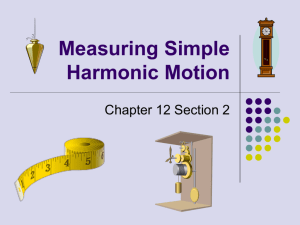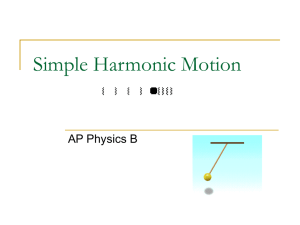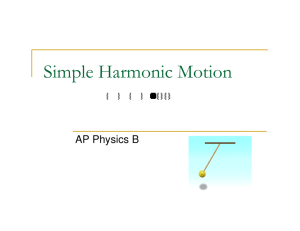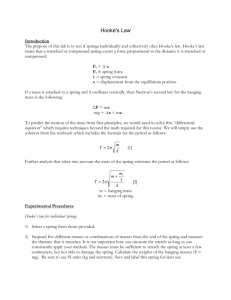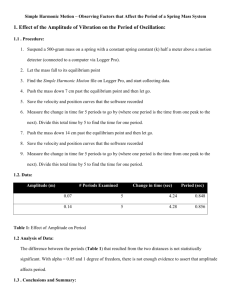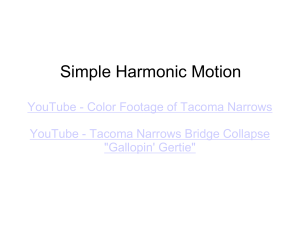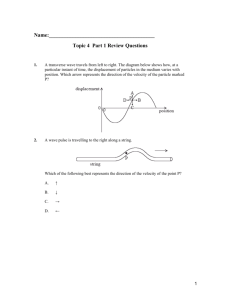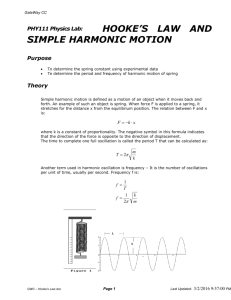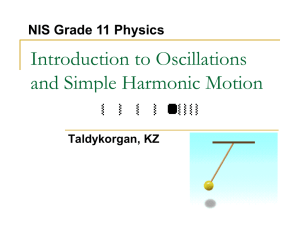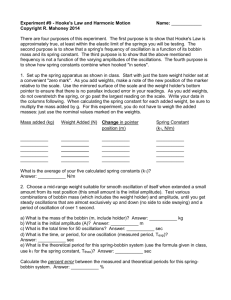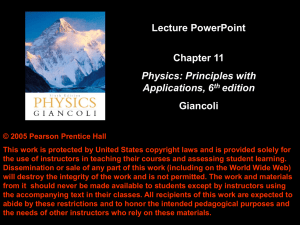Simple Harmonic Motion
advertisement
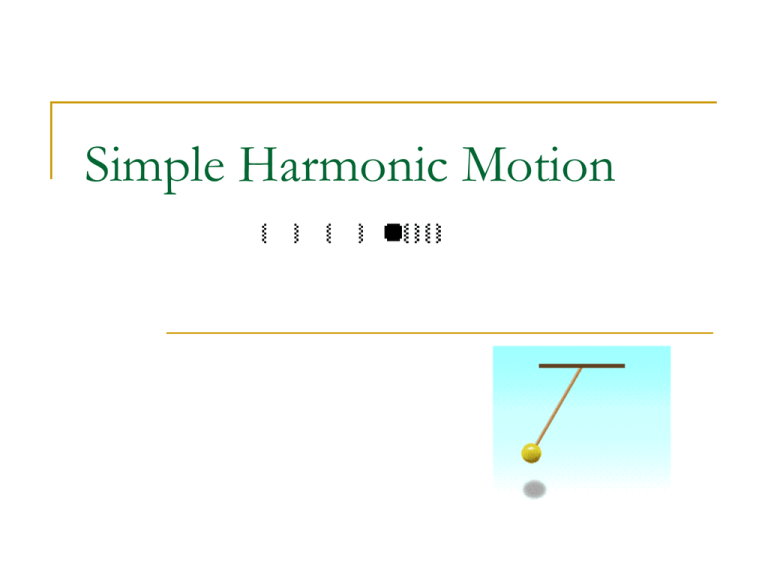
Simple Harmonic Motion Harmonic Motion Linear Motion- A B one place to another Harmonic Motion- Repeat over and over again ex. Swinging, walking in circles, pendulums, bicycle wheels etc. Cycle- building block of motion (back and forth one cycle) System – all things we are interested in, exclude things we don’t. Pendulum, system includes hanger, string and weight. Oscillator- any system that shows harmonic motion (heart, planets, pendulum etc.) Earth has several oscillating systems. Harmonic Motion Light and sound come from oscillations Sound- oscillation of air(speaker pushes and pulls on air creating an oscillation of pressure) Color- light waves are electromagnetic oscillations. Faster oscillations make blue, slower make red. Technology- Fast electromagnetic oscillation (cell phones 100 million cycles/sec) (FM radio 88 to 107 million cylces/sec) Harmonic Motion Period- time for 1 cycle Frequency- # of cycles per second Hertz = cycles/sec = Hz t = 1/f f= 1/t inversely related Amplitude- size of cycle, can be distance or angle Damping- friction eventually slows down all oscillations and lowers amplitude Frequency The FREQUENCY of a wave is the inverse of the PERIOD. That means that the frequency is the #cycles per sec. The commonly used unit is HERTZ(HZ). seconds 3.5s Period T 2s cycles 1.75cyc cycles 1.75cyc Frequency f 0.5 c 0.5Hz s seconds 3.5 sec 1 1 T f f T Pendulum Lab-only change 1 variable at a time! Part I: Part II Set up photogate so it can read as the ball passes through. Adjust things as many times as necessary but see what variable (amplitude, # of washers or length of string has biggest effect on Period. Make sure timer is set on Period (double the time for 1 full cycle) Put results in data table and write conclusion. Start at 30 degree amplitude, record time it takes to decrease down to 10 degree amplitude. Change mass 4 times, keeping string length constant. Change string length 4 times, keeping mass constant. Put results in data table and write conclusion. Springs are like Waves and Circles The amplitude, A, of a wave is the same as the displacement ,x, of a spring. Both are in meters. CREST Equilibrium Line Trough Ts=sec/cycle. Let’s assume that the wave crosses the equilibrium line in one second intervals. T =3.5 seconds/1.75 cycles. T = 2 sec. Period, T, is the time for one revolution or in the case of springs the time for ONE COMPLETE oscillation (One crest and trough). Oscillations could also be called vibrations and cycles. In the wave above we have 1.75 cycles or waves or vibrations or oscillations. Simple Harmonic Motion Back and forth motion that is caused by a force that is directly proportional to the displacement. The displacement centers around an equilibrium position. Fs x Springs – Hooke’s Law One of the simplest type of simple harmonic motion is called Hooke's Law. This is primarily in reference to SPRINGS. Fs x k Constantof Proportion ality k Spring Constant(Unit : N/m) Fs kx or kx The negative sign only tells us that “F” is what is called a RESTORING FORCE, in that it works in the OPPOSITE direction of the displacement. Hooke’s Law Common formulas which are set equal to Hooke's law are N.S.L. and weight Example A load of 50 N attached to a spring hanging vertically stretches the spring 5.0 cm. The spring is now placed horizontally on a table and stretched 11.0 cm. What force is required to stretch the spring this amount? Fs kx 50 k (0.05) k 1000 N/m Fs kx Fs (1000)(0.11) Fs 110 N Hooke’s law practice problems 1. What force is necessary to stretch an ideal spring whose force constant is 120. N/m by an amount of 30. cm? 2. A spring with a force constant of 600. N/m is used on a scale for weighing fish. What is the mass of a fish that would stretch the spring by 7.5 cm from its normal length? 3. A spring in a pogo-stick is compressed 12 cm when a 40. kg girl stands on the stick. What is the force constant for the pogo-stick spring? 4. ****An elastic cord is 80. cm long when it is supporting a mass of 10. kg hanging from it at rest at rest. When an additional 4.0 kg is added, the cord is 82.5 cm long. HINT: 4 kg stretches the cord 2.5 cm!! (a) What is the spring constant of the cord? (b) What is the length of cord when no mass is hanging from it? HINT once you have the k value, work the equation for spring force backwards!! THINK: How much does 10.kg STRETCH the cord?? 5. A spring is connected to a wall. A mass on a horizontal surface is connected to the spring and pulled to the right along the surface stretching the spring by 25 cm. If the pulling force exerted on the mass was 80.N, determine the spring constant of the spring. You then hang an unknown mass hanging from the spring causes the spring to stretch 15 cm, what is the mass of the unknown? Hooke’s law lab Purpose: Using the Springs and Swings apparatus, find the spring constant of each of 5 springs provided to you in lab. Label them with color and size. Procedure: Placing a mass on the bottom hook of the spring, record how far down the spring moves mg = k∆x the mass of each mass is 12 g. You may use as many of the masses as needed. Record all data in a data table and label the k value for each spring. Find the unknown mass: Using the information provided from your own data, find the mass of one individual magnet and of the plastic washer provided to your lab group. You may use any spring you wish, but you might want to use two or three to confirm your answer. Good Luck! Hooke’s Law from a Graphical Point of View Fs kx Suppose we had the following data: x(m) Force(N) 0 0 0.1 12 0.2 24 0.3 36 0.4 48 Fs x k Slope of a F vs. x graph k Force vs. Displacement y = 120x + 1E-14 R2 = 1 80 70 0.5 60 0.6 72 Force(Newtons) 60 50 k =120 N/m 40 30 20 10 0 0 0.1 0.2 0.3 0.4 Displacement(Meters) 0.5 0.6 0.7 We have seen F vs. x Before!!!! Force vs. Displacement Work or ENERGY = FDx y = 120x + 1E-14 R2 = 1 80 Since WORK or ENERGY is the AREA, we must get some type of energy when we compress or elongate the spring. This energy is the AREA under the line! 70 Force(Newtons) 60 50 40 30 Area = ELASTIC POTENTIAL ENERGY 20 10 0 0 0.1 0.2 0.3 0.4 0.5 0.6 0.7 Displacement(Meters) Since we STORE energy when the spring is compressed and elongated it classifies itself as a “type” of POTENTIAL ENERGY, Us. In this case, it is called ELASTIC POTENTIAL ENERGY. Elastic Potential Energy The graph of F vs.x for a spring that is IDEAL in nature will always produce a line with a positive linear slope. Thus the area under the line will always be represented as a triangle. NOTE: Keep in mind that this can be applied to WORK or can be conserved with any other type of energy. Conservation of Energy in Springs Example A slingshot consists of a light leather cup, containing a stone, that is pulled back against 2 rubber bands. It takes a force of 30 N to stretch the bands 1.0 cm (a) What is the potential energy stored in the bands when a 50.0 g stone is placed in the cup and pulled back 0.20 m from the equilibrium position? (b) With what speed does it leave the slingshot? a ) Fs kx 30 k (0.01) k 3000 N/m U s 1 kx 2 0.5(k )(.20) 2 2 b) E B E A U s K U s 1 m v2 1 (0.050)v 2 2 2 v 49 m/s 60 J SHM and Uniform Circular Motion Springs and Waves behave very similar to objects that move in circles. The radius of the circle is symbolic of the displacement, x, of a spring or the amplitude, A, of a wave. xspring Awave rcircle SHM and Uniform Circular Motion •The radius of a circle is symbolic of the amplitude of a wave. •Energy is conserved as the elastic potential energy in a spring can be converted into kinetic energy. Once again the displacement of a spring is symbolic of the amplitude of a wave •Since BOTH algebraic expressions have the ratio of the Amplitude to the velocity we can set them equal to each other. •This derives the PERIOD of a SPRING. Example A 200 g mass is attached to a spring and executes simple harmonic motion with a period of 0.25 s If the total energy of the system is 2.0 J, find the (a) force constant of the spring (b) the amplitude of the motion m 0.200 Ts 2 0.25 2 k k U s 1 kx2 2 1 kA2 2 2 k A 126.3 N/m 0.18 m Pendulums Pendulums, like springs, oscillate back and forth exhibiting simple harmonic behavior. A shadow projector would show a pendulum moving in synchronization with a circle. Here, the angular amplitude is equal to the radius of a circle. Pendulums Consider the FBD for a pendulum. Here we have the weight and tension. Even though the weight isn’t at an angle let’s draw an axis along the tension. q q mgcosq mgsinq m gsin q RestoringForce m gsin q kx Pendulums s s q R L s qL Am plitude m gsin q RestoringForce m gsin q kx m g sin q kqL sin q q , if q sm all m g kl m l k g Tspring m 2 k What is x? It is the amplitude! In the picture to the left, it represents the chord from where it was released to the bottom of the swing (equilibrium position). Tpendulum l 2 g Example A visitor to a lighthouse wishes to determine the height of the tower. She ties a spool of thread to a small rock to make a simple pendulum, which she hangs down the center of a spiral staircase of the tower. The period of oscillation is 9.40 s. What is the height of the tower? l TP 2 l height g 2 2 2 4 l T g 9 . 4 (9.8) 2 P TP l 2 2 g 4 4(3.141592) L = Height = 21.93 m
